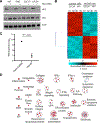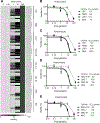Ketoconazole and Posaconazole Selectively Target HK2-expressing Glioblastoma Cells
- PMID: 30322879
- PMCID: PMC8103287
- DOI: 10.1158/1078-0432.CCR-18-1854
Ketoconazole and Posaconazole Selectively Target HK2-expressing Glioblastoma Cells
Abstract
Purpose: Hexokinase II (HK2) protein expression is elevated in glioblastoma (GBM), and we have shown that HK2 could serve as an effective therapeutic target for GBM. Here, we interrogated compounds that target HK2 effectively and restrict tumor growth in cell lines, patient-derived glioma stem cells (GSCs), and mouse models of GBM.Experimental Design: We performed a screen using a set of 15 drugs that were predicted to inhibit the HK2-associated gene signature. We next determined the EC50 of the compounds by treating glioma cell lines and GSCs. Selected compounds showing significant impact in vitro were used to treat mice and examine their effect on survival and tumor characteristics. The effect of compounds on the metabolic activity in glioma cells was also assessed in vitro.
Results: This screen identified the azole class of antifungals as inhibitors of tumor metabolism. Among the compounds tested, ketoconazole and posaconazole displayed the greatest inhibitory effect on GBM both in vitro and in vivo. Treatment of mice bearing GBM with ketoconazole and posaconazole increased their survival, reduced tumor cell proliferation, and decreased tumor metabolism. In addition, treatment with azoles resulted in increased proportion of apoptotic cells.
Conclusions: Overall, we provide evidence that azoles exert their effect by targeting genes and pathways regulated by HK2. These findings shed light on the action of azoles in GBM. Combined with existing literature and preclinical results, these data support the value of repurposing azoles in GBM clinical trials.
©2018 American Association for Cancer Research.
Conflict of interest statement
Disclosure of Potential Conflicts of Interest
No potential conflicts of interest were disclosed.
Figures





References
-
- Mathupala SP, Rempel A, Pedersen PL. Glucose catabolism in cancer cells: identification and characterization of a marked activation response of the type II hexokinase gene to hypoxic conditions. J Biol Chem 2001;276: 43407–12. - PubMed
-
- Pedersen PL, Mathupala S, Rempel A, Geschwind JF, Ko YH. Mitochondrial bound type II hexokinase: a key player in the growth and survival of many cancers and an ideal prospect for therapeutic intervention. Biochim Biophys Acta 2002;1555:14–20. - PubMed
Publication types
MeSH terms
Substances
Grants and funding
LinkOut - more resources
Full Text Sources

